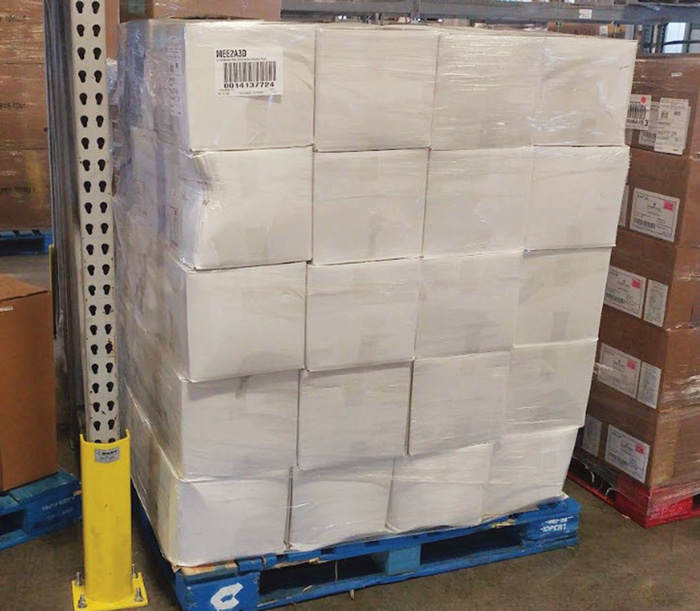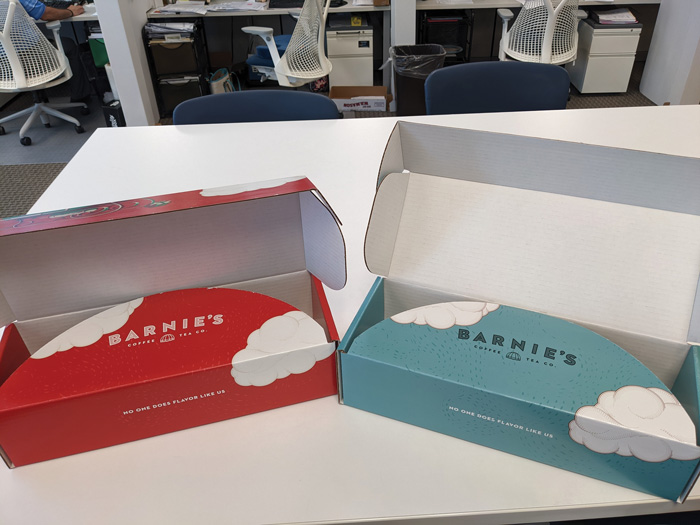E-Commerce Packaging Delivers
Packaging | APPLIED SCIENCE
In the United States, retail e-commerce sales of all food and beverage purchases are projected to grow 16% in 2022, and about 40% of brand owners expect to change their packaging to capitalize on this trend. But packaging for e-commerce differs from that required by brick-and-mortar retailers. E-commerce packaging demands are unique, including the need for brand transfer at the doorstep, limiting the damage during transit, addressing diversion prevention and food safety, and considering environmental cost.
Brand Communication on the Doorstep
Pet foods provide a good example of the need for brand transfer at the doorstep when packaging for e-commerce. Brick-and-mortar retailer out-of-stocks of pet foods are more than double than those of online platforms. In fact, 35% of all pet food is delivered via e-commerce, a volume projected to reach 54% by 2025 (Phillips-Donaldson 2021). Online pet food retailers communicate the e-store brand using the outer packaging.
For example, Chewy uses the e-commerce platform to convey store branding via B-flute printed on four sides with the Chewy logo within a colored block billboard. The consumer unboxing experience is inconsequential in its simplicity, and the outer cases contain different brands of products ordered, as well as flexible paper dunnage to limit movement within the case. This allows for ease of packaging within limited case size options within the Chewy distribution system. Additionally, Chewy supplies directions for the empty corrugated cases, allowing the Chewy billboard to continue in the home as a cat tower, palace, or fort.
Kyle Yerdon, lead packaging design engineer at Dusobox Corp., adds that using print to convey food quality via e-commerce also is on trend in e-commerce packaging, noting that products such as Barnie’s Coffee and Tea gift set require a high degree of finesse. A high-quality unboxing experience is created by printing both an insert and case with a four-color process and 80 lb lithographic label onto 200 lb B white two-sided corrugated cardboard, he explains. Alternatively, many e-commerce outer shipping cases are printed with plain nondescript graphics on the outside to limit diversion.
“The focus is on the unboxing experience to convey the brand image,” Yerdon says. “Printing using lithography on the inside of the shipping case limits the washboarding associated with flexographic printing. In many situations, the inside of the case is printed and in the unboxing process, the shipping case pops open like a children’s book to reveal all the beautiful graphics on the inside. These are usually affixed with a tape and zip strip for ease of opening.”
Other packaging is designed to mimic the retailer or restaurant consumer experience. In the food broth category, three different types of e-commerce are used to accomplish this. Pacific Foods uses aseptic processing and packaging in a multilayer carton that does not require a cold chain to mimic the consumer packaging experience as purchased at a brick-and-mortar retail store. Likewise, dehydrated powders packaged within high-barrier pouches such as BareBones do not require refrigeration. In these two scenarios, the multi-serving package is used by the consumer to dispense broth into a cup. And packages can be combined with other branded products in a combined ambient delivery. Branding is conveyed much in the same way as consumers see brands when unpacking groceries purchased from a brick-and-mortar retailer.
In contrast, other broth brands, such as Brodo, package individual servings of broth within coated paperboard-based cups to match the restaurant experience of consumers. Lidded cups are separated with a corrugated divider and ice packets keep the product cold within an outer case of green cell foam (Temperpack), which is disposed of by landfilling, incinerating, or dissolving in the consumer’s sink with water. The packaged product is then placed in an outer white shipping case with a Brodo billboard on all four sides. Direct shipping from Brodo achieves the twin advantages of conveying the brand image on the outer shipping case and allowing consumers to connect with the in-restaurant experience through the packaging. However, the need for ice packs as well as refrigeration translates to more costly packaging.
Limiting Damage
Product is damaged differently in e-commerce because it is handled individually in distribution centers and then shipped directly to consumers versus a pallet load shipped to brick-and-mortar distribution centers and retailers. In addition, handling is primarily by forklift through most of the brick-and-mortar supply chain, which is not valid for single parcel shipments. Thus, different package designs, materials, and amounts of packaging are needed for adequate product protection during e-commerce.
Entities such as the National Motor Freight Traffic Association and International Safe Transit Association aid in reducing damage and optimizing less-than-truckload (LTL) shipping. Package testing to assess fitness for e-commerce direct from brand to consumer requires specific protocols. Fortunately, the International Safe Transit Association (ISTA) studies global supply chains and provides guidance and education. Test procedures have been created to mimic Amazon, single parcel carriers, LTL carriers, and Sam’s Club. For example, specific testing protocols differ for packaging that ships in own container or ships LTL without additional packaging supplied by Amazon. In addition, there are specific testing protocols for products in retail packaging that are not capable of surviving parcel handling or of being combined with other packaged products shipped in an Amazon or other e-tailer branded overbox. In both cases, additional packaging is needed to protect product.
Due to the increase in shocks and uncontrolled orientation faced by small shipments versus pallet load distribution associated with brick-and-mortar retail, e-commerce packaging requires more rugged retail packaging protection or the means to mitigate shock or prevent leaking. This additional packaging, including the shipping case, is flexible dunnage to limit contact between packages that could result in punctures or scuffing. Patrick McDavid, an expert in e-commerce packaging and senior packaging engineer at ABF Freight, notes that when companies decide that packaging cost is their sole decision driver, ignoring the sustainability and emotional impacts of packaging, “the solution is not solid.”
McDavid urges testing to address all factors. “Proper pre-shipment testing ensures that product is not underprotected, which leads to food and packaging waste, overpackaged [product], or the use of too much packaging. The emotional impact is where the customer comes in. In e-commerce, consumer perceptions are based on the moment of delivery through the unboxing experience.”
He adds that perceived damage is almost as important as actual damage since the consumer might believe something is wrong and refuse the shipment even though the product inside might be fine. In addition, he says, companies that overpackage face consumer ire (McDavid 2019).
Beverage packaging, which experienced a 40% increase in 2020, provides a window into the differences faced by foods in general. Two-thirds of e-commerce beverage purchases are for nonalcoholic products. For beverages, damage rates in e-commerce platforms as compared to brick-and-mortar stores vary by defect (Orendorff 2022). About 52.6% of beverages purchased in PET bottles were purchased via e-commerce. For beverages, distribution defects that occur during e-commerce transit are dominated by shock-related defects, which are 9% higher than in brick-and-mortar formats (Spruit and Almenar 2021).
In contrast, brick-and-mortar commonly faces defects with equal amounts of shock, vibration, and static conditions. Dylan Spruit, a packaging scientist with The Clorox Co., says that one aspect of his research assessed likely package format changes to align with e-commerce. “Pouches were the preference stated, due to the need for lightweighting and desire for damage reduction to prevent product/package waste,” Spruit notes. “This led to participants perceiving that pouches perform the best in this distribution environment.” Similar seal and closure-derived leakage were found in beverages distributed in brick-and-mortar and e-commerce, likely because seals and closures are not directly affected by e-commerce shocks, he added.
Ensuring Food Safety
Packaging’s role in ensuring food safety extends from farm to fork, regardless of whether product is delivered by e-commerce or a brick-and-mortar retailer. Of paramount importance in both distribution systems is the need for a reliable distribution temperature. In terms of food safety, this usually involves two areas: maintaining low temperatures to prevent the growth of pathogens and/or maintaining a narrow temperature window that ensures that product does not respire too rapidly and undergo microbial growth or freeze. While reliable cold chains exist to support brick-and-mortar retailers, e-commerce, with its inherently variable delivery systems, times, and distribution ranges, requires different packaging technology and careful attention.
Meal kits that contain uncooked meat, produce, and other items require inner variable temperature control within the meal kit itself. For example, meal kit company Blue Apron requires packaging to maintain temperature during distribution. The outer package contains a label with a product list and the specific location of origin for all products within the shipping case. This immediately connects consumers to the product within the case. To maintain the temperature, top and bottom packs of Enviro Ice (Frosty Tech) are used in two formulations to maintain 32°F or 10°F within a Temperpack case that fits into the outer corrugated shipping case.
Enviro Ice is contained within a low-density polyethylene pouch suitable for store drop-off recycling and contains “drainable gel” for disposal in a household drain or for use watering plants. Temperpack consists of paperboard outer facings that enrobe insulation and has a two-piece design with integrated folds to reduce the complexities of packaging operations. Within this cold chain construct, packs of breathable produce bags and premeasured ingredients are within a bag for each meal and placed on top of heavier meat, fish, and an additional ice pack. Other meal kits, such as Thistle, minimize packaging within reusable totes. Compared to packaging for products in brick-and-mortar stores, smaller quantities within the meal kit packages require a higher package-to-product ratio and therefore, more packaging on a per-ounce basis than larger sizes available from brick-and-mortar retailers. However, less food waste can result from the use of premeasured ingredients.
Temperature abuse also is a cause of e-commerce packages and resulting product defects (Ndraha et al. 2018). Therefore, inhibiting food safety risk requires using time and temperature indicators and integrators on cases to mimic the capability of those commonly employed on pallet loads to stock brick-and-mortar stores. This includes track-and-trace approaches using intelligent packaging (Sand 2020).
Learning Objectives
- Grasp how the role of product protection is different for brick-and-mortar retail and e-commerce.
- Define means to convey the brand image, reduce damage, and ensure food safety.
- Apply resources to develop adequate e-commerce packaging.






